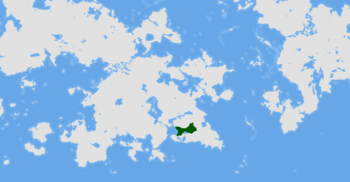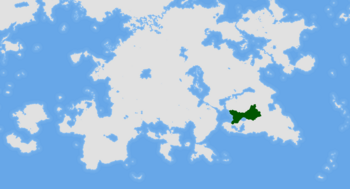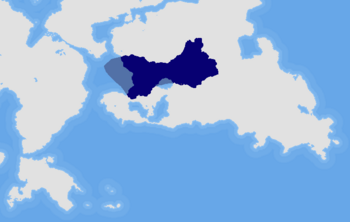Federation of Yugoslavia: Difference between revisions
Yugoslavia (talk | contribs) No edit summary |
Yugoslavia (talk | contribs) No edit summary |
||
| Line 84: | Line 84: | ||
The '''Federation of Yugoslavia''', officially the '''Royal State of the Federation of Yugoslavia''' ([[Chernogorkan]]: ''Koroljevska Deržava Federacije Jugoslavije'', Королйевска Держава Федерацийе Йугославийе; known informally as '''Yugoslavia''') is a country located in the Southeastern [[Thrismari]]. It is surrounded by [[Lindstaten]] to the north, [[Wassilia]] to the east, [[Sacrofnia]] and the [[Kolpa Lake]] to the south, and the [[Kaldaz Ocean]] shoreline to the west. It's three federated units, ''krajine/крайине'', and the [[Chernograd Capital District|capital district]] comprise a total area of 486,255.971 km<sup>2</sup> (187,744.48 square miles), on which reside 83,772,916 residents (2019 Census), corresponding to 172.28 per km<sup>2</sup> (446.21 per sq mi). Yugoslavia is a parliamentary democracy under a constitutional monarchy, ruled by king [[King Paul I of Yugoslavia|Paul I]] of the [[House of Karažev]] since 1992. The federal capital is [[Chernograd Capital District|Chernograd]] (Chernogorkan: ''Černograd'', Черноград; lit. ''black city''), a city of more than 8 million people situated on the shores of Kolpa Lake; the city is the financial, industrial, and scientific centre of Yugoslavia, hosting the [[Royal Institute of Science]] and the [[University of Chernograd]]. The entire nation is mostly flat in the interior; the littoral region is moderately hilly and uneven, while the eastern borderlands with Wassilia are composed of mostly low summits and peaks of the [[Trizub Range|Trizub mountain range]]. The highest summit is in the northeasternmost corner of the country, [[Sventovid Peak]], measuring at 2,063 metres above sea level. | The '''Federation of Yugoslavia''', officially the '''Royal State of the Federation of Yugoslavia''' ([[Chernogorkan]]: ''Koroljevska Deržava Federacije Jugoslavije'', Королйевска Держава Федерацийе Йугославийе; known informally as '''Yugoslavia''') is a country located in the Southeastern [[Thrismari]]. It is surrounded by [[Lindstaten]] to the north, [[Wassilia]] to the east, [[Sacrofnia]] and the [[Kolpa Lake]] to the south, and the [[Kaldaz Ocean]] shoreline to the west. It's three federated units, ''krajine/крайине'', and the [[Chernograd Capital District|capital district]] comprise a total area of 486,255.971 km<sup>2</sup> (187,744.48 square miles), on which reside 83,772,916 residents (2019 Census), corresponding to 172.28 per km<sup>2</sup> (446.21 per sq mi). Yugoslavia is a parliamentary democracy under a constitutional monarchy, ruled by king [[King Paul I of Yugoslavia|Paul I]] of the [[House of Karažev]] since 1992. The federal capital is [[Chernograd Capital District|Chernograd]] (Chernogorkan: ''Černograd'', Черноград; lit. ''black city''), a city of more than 8 million people situated on the shores of Kolpa Lake; the city is the financial, industrial, and scientific centre of Yugoslavia, hosting the [[Royal Institute of Science]] and the [[University of Chernograd]]. The entire nation is mostly flat in the interior; the littoral region is moderately hilly and uneven, while the eastern borderlands with Wassilia are composed of mostly low summits and peaks of the [[Trizub Range|Trizub mountain range]]. The highest summit is in the northeasternmost corner of the country, [[Sventovid Peak]], measuring at 2,063 metres above sea level. | ||
The first traces of human activity in the lands of contemporary Yugoslavia are about 1.1 million years old. About 350,000 years ago, there are traces of Neanderthal presence in Yugoslavia, located in [[Velika Plana cave]] of the Trizub mountain range. Cro-magnons appeared some 40,000 years ago, but have left no significant traces of their presence, possibly because the ''Homo sapiens'' arrived approximately 10,000 years later and became the dominant variant of modern humans. Neolithic era brought about [[Halka culture]] around the Kolpa | The first traces of human activity in the lands of contemporary Yugoslavia are about 1.1 million years old. About 350,000 years ago, there are traces of Neanderthal presence in Yugoslavia, located in [[Velika Plana cave]] of the Trizub mountain range. Cro-magnons appeared some 40,000 years ago, but have left no significant traces of their presence, possibly because the ''Homo sapiens'' arrived approximately 10,000 years later and became the dominant variant of modern humans. Neolithic era brought about [[Halka culture]] around the Kolpa Lake, and [[Janski culture]] in the littoral region, and both left several localities abundant with artefacts, which showed that these dwellers were technologically more developed than similar cultures, which is proved by evidence of their engaging in agriculture and livestock raising. These cultures were lost to us around 5 000 BCE, and traces of human activity reappear in 1000 BCE, with the arrival of Proto-Slavonic peoples to the shores of Kolpa Lake. It is not known who were these people, nor how they arrived, but by the time Slavs arrived in the 6th century CE they had largely disappeared. Slavs subdued the local population and lived in tribal societies, until the rise of the [[Duchy of Gorka]] in the 10th century (probably in 926) by the [[Duke Nikolaj I|duke Nikolaj Mogelov]]. The Duchy lasted until 1231, when it crumbled under the Christianisation armies led by [[Methodius the Bright]], who split the duchy into multiple bishoprics tasked with converting Slavs to Christianity. | ||
Modern Yugoslavia was created after the [[Unification Referendum of 1953]], which was the result of many economic and political crises in the [[Republic of Chernozemye]] and the [[Kingdom of Gorka]]. The referendum received widespread support in both countries, and the results precipitated the unification of Chernozemye and Gorka on 14th January 1955 into the Federation of Yugoslavia under the House of Karažev, which ruled Gorka since 1711. The current [[King of Yugoslavia]] is Paul I, who ascended the throne following his father's death in February of 1992; his coronation took place on 1st September 1992. | |||
Today, Yugoslavia is a regional pillar of scientific research and cultural heritage. The Royal Institute of Science, a prestigious facility in Chernograd running since 1972, is entirely funded by the royal family, and is the most prestigious education hub for STEM fields in the country, and beyond. Since 1990s, the standard of living in Yugoslavia increased dramatically, and today hosts productive populace and a resilient and diversified economy. It remains one of the most influential and developed Slavic nations in [[Anteria]]. | |||
__TOC__ {{TOC right}} | |||
== Etymology == | |||
The name ''Yugoslavia'', an anglicised transcription of ''Jugoslavija'', is a compound word made up of ''jug'' ('yug'; with the 'j' pronounced like an English 'y') and ''slavija''. The Slavic word ''jug'' means 'south', while ''slavija'' ("Slavia") denotes a 'land of the Slavs'. Thus, a translation of Jugoslavija would be 'South-Slavia' or 'Land of the South Slavs'. It was used informally for the lands of Chernozemye and Gorka since the beginning of the 19th century, popularised after the ''[[Slavic Renaissance]]'' movement. | |||
Revision as of 22:36, 22 November 2023
Royal State of the Federation of Yugoslavia Koroljevska Deržava Federacije Jugoslavije (Chernogorkan)
Королйевска Держава Федерацийе Йугославийе (Cyrillic) | |
|---|---|
| Motto: Jeden narod, jeden korolj, jedna deržava "One people, one king, one state" | |
| Anthem: "Hej Slaveni!" "Hey Slavs!" | |
Location of Yugoslavia (blue or dark green) | |
| Capital and largest city | Chernograd |
| Official languages | Chernogorkan |
| Recognised national languages | Chernogorkan, Cordomonivence Slavonic |
| Ethnic groups (2019) | Chernozemci (43%) Gorkanki (31%) Storonci (11%) Morrawian (9%) Other (6%) |
| Demonym(s) | Yugoslav |
| Government | Parliamentary democracy under a constitutional monarchy |
• King of Yugoslavia | Paul I |
• Prime Minister | Nikolaj Novosel |
| Legislature | The Federal Assembly of Yugoslavia |
| The Royal Council | |
| The House of Peoples | |
| Establishment | |
• Arrival of the Slavs | 6th century |
• Duchy of Gorka | 10th century |
• Great Peasant Rising | 1493 |
• Kingdom of Gorka | 1711 |
• Liberation of Chernozemye | 27th August 1815 |
• Unification referendum | 18th November 1953 |
• Federation of Yugoslavia | 14th January 1955 |
• Coronation of Paul I | 1st December 1992 |
| Area | |
• Total | 486,255.971 km2 (187,744.480 sq mi) |
| Population | |
• 2022 estimate | 84,833,022 |
• August 2019 census | 83,772,916 |
• Density | 172.28/km2 (446.2/sq mi) |
| GDP (PPP) | 2022 estimate |
• Total | $3,828 trillion |
• Per capita | $45 695 |
| GDP (nominal) | 2022 estimate |
• Total | $2,711 trillion |
• Per capita | $32 381 |
| Gini (2019) | low |
| HDI (2018) | very high |
| Currency | Yugoslav dinar (đ) 1đ:1.17€ |
| Time zone | UTC 0 |
| Date format | dd. mm. yyyy. |
| Driving side | right |
| Calling code | +38 |
| ISO 3166 code | YU |
| Internet TLD | .yu |
The Federation of Yugoslavia, officially the Royal State of the Federation of Yugoslavia (Chernogorkan: Koroljevska Deržava Federacije Jugoslavije, Королйевска Держава Федерацийе Йугославийе; known informally as Yugoslavia) is a country located in the Southeastern Thrismari. It is surrounded by Lindstaten to the north, Wassilia to the east, Sacrofnia and the Kolpa Lake to the south, and the Kaldaz Ocean shoreline to the west. It's three federated units, krajine/крайине, and the capital district comprise a total area of 486,255.971 km2 (187,744.48 square miles), on which reside 83,772,916 residents (2019 Census), corresponding to 172.28 per km2 (446.21 per sq mi). Yugoslavia is a parliamentary democracy under a constitutional monarchy, ruled by king Paul I of the House of Karažev since 1992. The federal capital is Chernograd (Chernogorkan: Černograd, Черноград; lit. black city), a city of more than 8 million people situated on the shores of Kolpa Lake; the city is the financial, industrial, and scientific centre of Yugoslavia, hosting the Royal Institute of Science and the University of Chernograd. The entire nation is mostly flat in the interior; the littoral region is moderately hilly and uneven, while the eastern borderlands with Wassilia are composed of mostly low summits and peaks of the Trizub mountain range. The highest summit is in the northeasternmost corner of the country, Sventovid Peak, measuring at 2,063 metres above sea level.
The first traces of human activity in the lands of contemporary Yugoslavia are about 1.1 million years old. About 350,000 years ago, there are traces of Neanderthal presence in Yugoslavia, located in Velika Plana cave of the Trizub mountain range. Cro-magnons appeared some 40,000 years ago, but have left no significant traces of their presence, possibly because the Homo sapiens arrived approximately 10,000 years later and became the dominant variant of modern humans. Neolithic era brought about Halka culture around the Kolpa Lake, and Janski culture in the littoral region, and both left several localities abundant with artefacts, which showed that these dwellers were technologically more developed than similar cultures, which is proved by evidence of their engaging in agriculture and livestock raising. These cultures were lost to us around 5 000 BCE, and traces of human activity reappear in 1000 BCE, with the arrival of Proto-Slavonic peoples to the shores of Kolpa Lake. It is not known who were these people, nor how they arrived, but by the time Slavs arrived in the 6th century CE they had largely disappeared. Slavs subdued the local population and lived in tribal societies, until the rise of the Duchy of Gorka in the 10th century (probably in 926) by the duke Nikolaj Mogelov. The Duchy lasted until 1231, when it crumbled under the Christianisation armies led by Methodius the Bright, who split the duchy into multiple bishoprics tasked with converting Slavs to Christianity.
Modern Yugoslavia was created after the Unification Referendum of 1953, which was the result of many economic and political crises in the Republic of Chernozemye and the Kingdom of Gorka. The referendum received widespread support in both countries, and the results precipitated the unification of Chernozemye and Gorka on 14th January 1955 into the Federation of Yugoslavia under the House of Karažev, which ruled Gorka since 1711. The current King of Yugoslavia is Paul I, who ascended the throne following his father's death in February of 1992; his coronation took place on 1st September 1992.
Today, Yugoslavia is a regional pillar of scientific research and cultural heritage. The Royal Institute of Science, a prestigious facility in Chernograd running since 1972, is entirely funded by the royal family, and is the most prestigious education hub for STEM fields in the country, and beyond. Since 1990s, the standard of living in Yugoslavia increased dramatically, and today hosts productive populace and a resilient and diversified economy. It remains one of the most influential and developed Slavic nations in Anteria.
Etymology
The name Yugoslavia, an anglicised transcription of Jugoslavija, is a compound word made up of jug ('yug'; with the 'j' pronounced like an English 'y') and slavija. The Slavic word jug means 'south', while slavija ("Slavia") denotes a 'land of the Slavs'. Thus, a translation of Jugoslavija would be 'South-Slavia' or 'Land of the South Slavs'. It was used informally for the lands of Chernozemye and Gorka since the beginning of the 19th century, popularised after the Slavic Renaissance movement.


